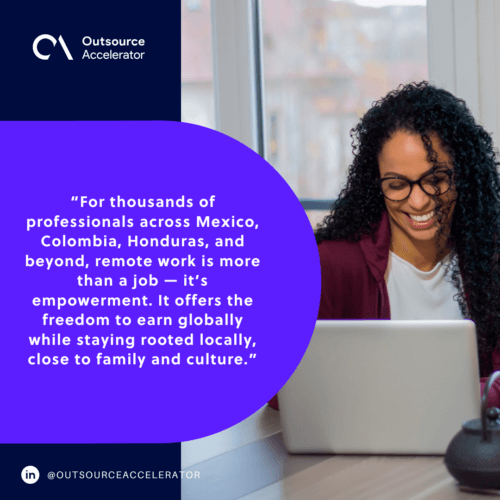Remote talent in Latin America: Your strategic asset for global growth

The world of work has changed forever — and nowhere is this transformation more exciting than in Latin America. Once seen as a traditional labor market, the region is now bursting with ambitious, highly skilled professionals eager to connect with global opportunities.
As Jaime Nacach, founder and CEO of Virtual Latinos, puts it in the 559th episode of the Outsource Accelerator Podcast:
“We’re still at the very beginning of people understanding the great potential of working remotely.”
That potential is now undeniable. For businesses seeking agility, cultural compatibility, and strong communication — Latin America’s remote talent represents a strategic advantage.
This article explores the strengths of remote talent from Latin America and how you can get in on this resource.
The emergence of remote work in Latin America
The COVID-19 pandemic forced companies worldwide to rethink traditional employment models. Even today, experts have noted that the remote and hybrid models still have staying power.
In Latin America, it did something even more profound — it opened doors to global participation.
“People had to look for remote jobs, and [they] started to get a lot more awareness of the potential to actually stay home and still make a living.”
For thousands of professionals across Mexico, Colombia, Honduras, and beyond, remote work is more than a job — it’s empowerment. It offers the freedom to earn globally while staying rooted locally, close to family and culture.
And for businesses, this evolution means access to a rich pool of professional talent aligned in both time zone and values.

Profile of the remote talent in Latin America
The modern Latin American remote professional is multilingual, educated, and adaptive — a strong communicator with a keen sense of collaboration.
Jaime describes them best:
“The people that we are able to find [for] our clients are really high-level, professional, mature, and highly-vetted.”
For example, Virtual Latinos’s talent operates from home offices across 20+ countries, spanning roles in administration, marketing, customer support, and finance. Many have prior experience working with international clients, giving them a natural fluency in cross-cultural teamwork.
Yet, as Jaime admits, language and education remain regional hurdles. Notably, no Latin American country reaches a Very High Proficiency rating, according to EF Education First.
“This is the number one reason we deny people from joining our community — because their English is just not that good enough for our clients.”
To address that, more professionals are taking online certification courses, learning new tools, and improving their English fluency — investing in their own growth to meet global expectations.
5 advantages of hiring remote talent in Latin America
The advantages of Latin America’s remote workforce go far beyond cost savings. Businesses that tap into this market gain a blend of skill, empathy, and alignment that’s hard to find elsewhere.
Here are five standout advantages:
1. Time zone compatibility
For North American companies, working with Latin American professionals means real-time collaboration. That results in no midnight meetings or delayed responses.
As Jaime notes, “It’s more of a competitive advantage to just focus on Latin America — for those who are looking to hire people from the same time zone.”
2. Cultural alignment and communication
Shared cultural touchpoints — from language nuances to business etiquette — make teamwork more seamless.
Latin professionals are known for empathy and adaptability, two essential qualities for customer-facing and collaborative roles.
3. High professional standards
Latin America’s remote talent is not only qualified but deeply committed. Many come from corporate or professional service backgrounds and bring a strong sense of accountability.
Jaime emphasizes this maturity in Virtual Latinos over the years: “We wanted to showcase the value, quality, and maturity that we’ve reached as a company.”
4. Economic and social empowerment
Stepping back from the pure business benefits, this outsourcing option also offers some social initiatives.
For workers, remote jobs open life-changing opportunities.
“They’re able to make a much better living [and] stay close to their families — while still building their lives positively,” says Jaime. This empowerment translates into motivated, loyal team members.
5. Expanding talent supply
The momentum keeps growing. As digital infrastructure improves and awareness spreads, Latin America’s pool of remote professionals continues to deepen.
“We’ve been blessed with so much demand just from Latin America — there’s still plenty of potential to continue to just grow in this area.”

Best practices for hiring and managing LatAm remote talent
Hiring remote professionals from Latin America requires more than a job post — it takes thoughtful planning, clear communication, and trust. Jaime’s insights reveal how to create partnerships that thrive.
Here are five best practices to follow:
1. Hire for skills, not geography
Jaime stresses a merit-based approach: “We fully focus on just finding the best talent regardless of what country it’s in.”
Latin America is diverse, but excellence knows no borders. Evaluate candidates on experience, communication, and cultural fit, not location.
2. Set clear expectations and boundaries
Remote collaboration works best when structure meets flexibility. Define goals, deliverables, and meeting rhythms early.
This clarity builds mutual respect, which is the foundation for strong working relationships.
3. Build trust through transparency
Outsourcing often fails not because of skill gaps, but trust gaps. Jaime learned that firsthand, recalling in the podcast of an unfortunate offshoring experience.
That experience led him to prioritize accountability, reliability, and honest communication between clients and professionals.
4. Focus on relationship-building, not transactions
Short-term freelancing might save money upfront, but long-term partnerships deliver real impact.
“The ability to introduce a client to a VA and a VA to a client that ends up building something that’s not just transactional, but an actual relationship that lasts many months or years.
According to Jaime, that’s what really makes a difference.
5. Invest in ongoing development
Continuous learning is key to keeping remote teams sharp and engaged.
Jaime highlights the importance of upskilling: “If we empower them to have more knowledge and be better at what they do — whether they get hired or not — we’re uplifting their lives.”
Supporting professional growth isn’t just good ethics. It’s good business.
Latin America’s remote professionals are redefining what global collaboration looks like, blending warmth, professionalism, and ambition in ways that inspire.
For forward-thinking companies, this region’s remote talent isn’t just a workforce solution; it’s a strategic asset for sustainable global growth.







 Independent
Independent




